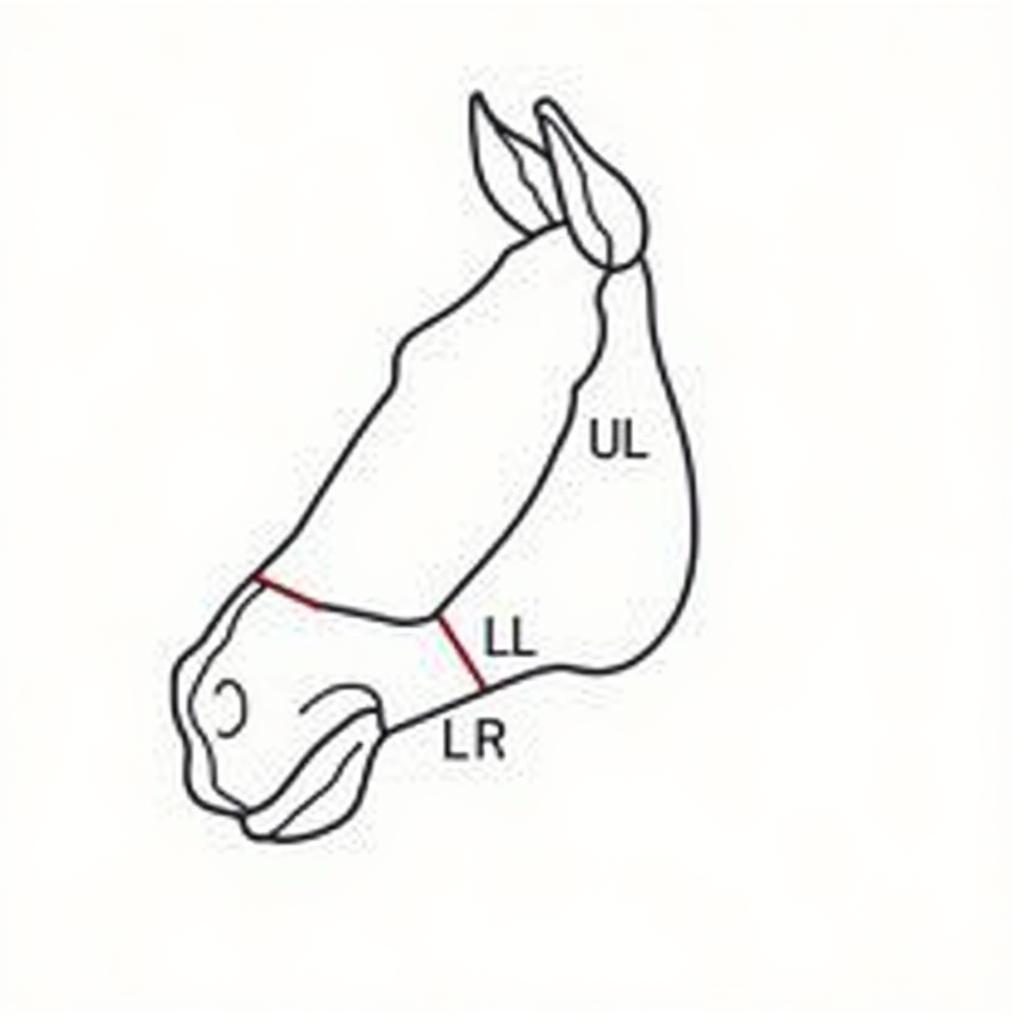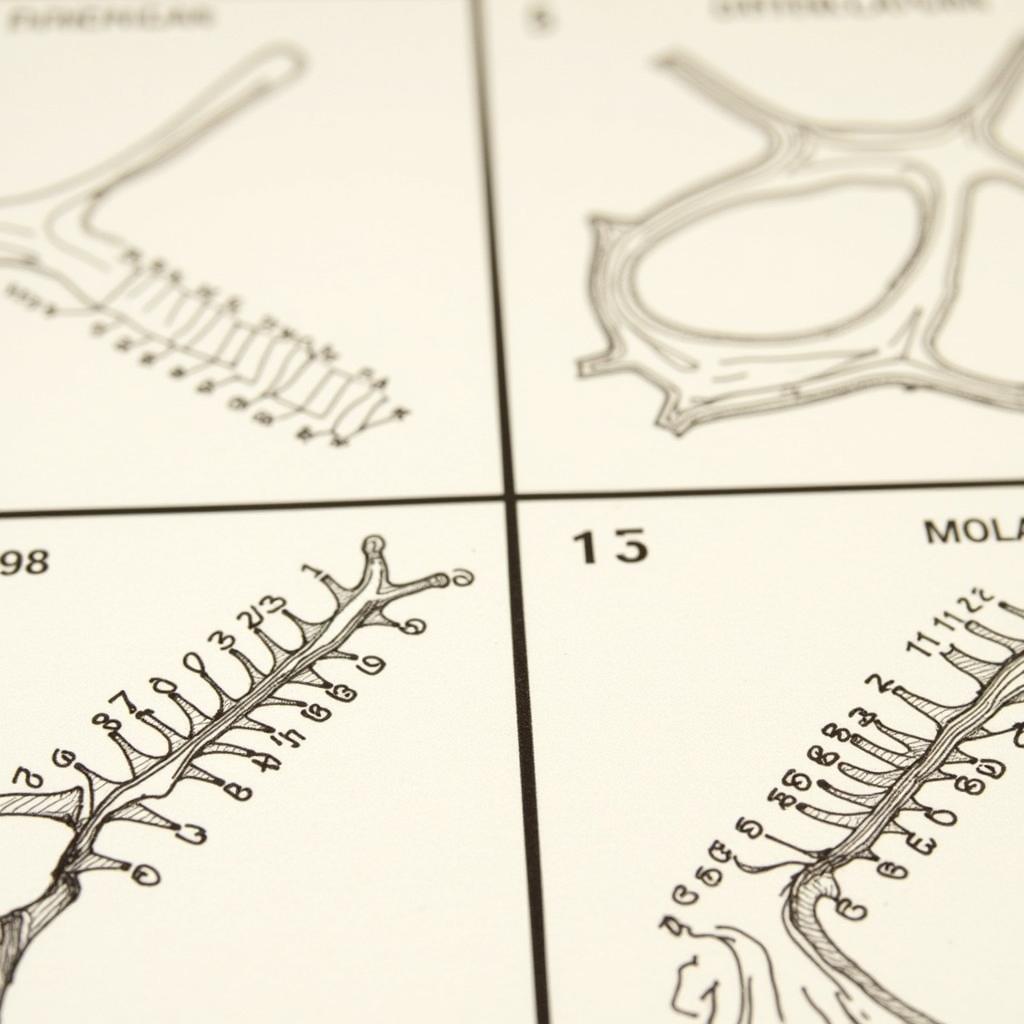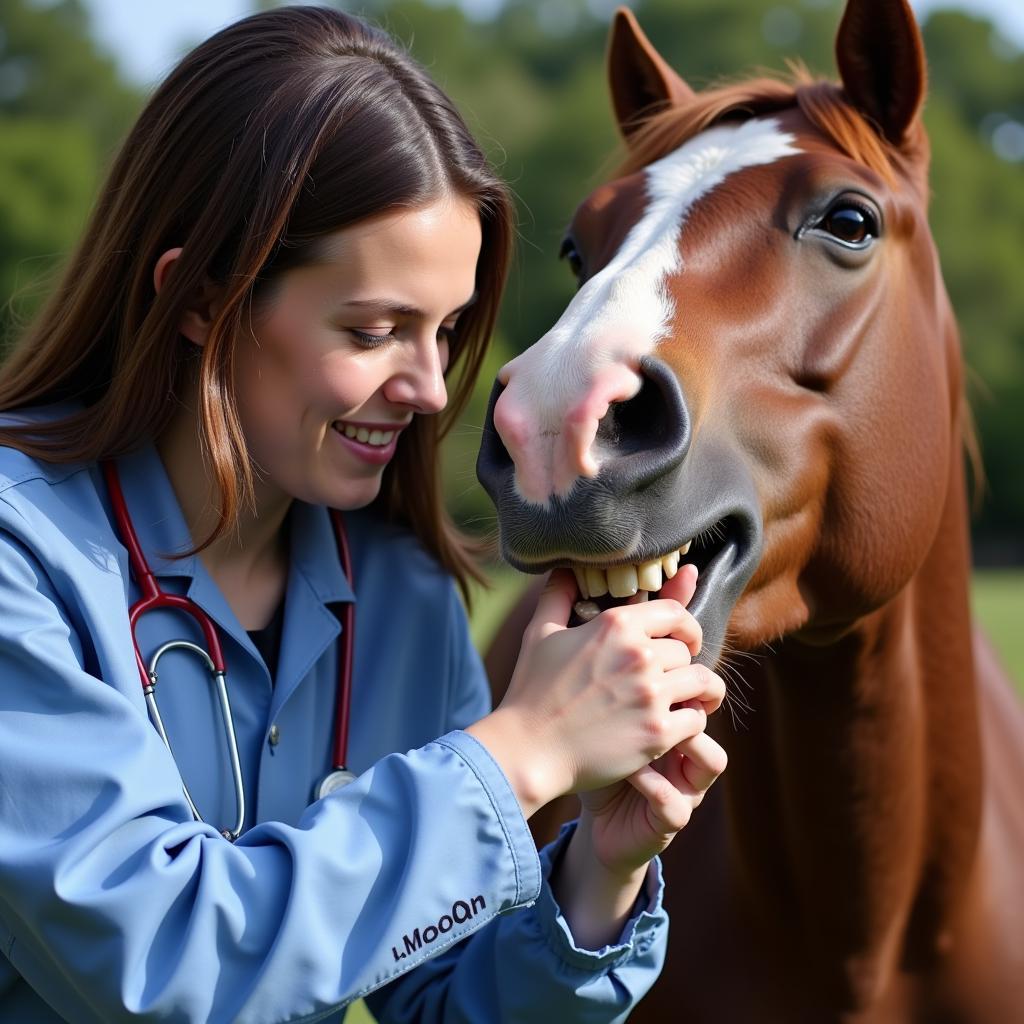A Horse Dental Chart, also known as an equine dental chart, is an essential tool for any horse owner, veterinarian, or equine professional. It provides a visual representation of a horse’s mouth, allowing for detailed record-keeping of each tooth’s condition, treatments performed, and any abnormalities observed.
Understanding the layout and information contained within a horse dental chart can be incredibly beneficial in maintaining your equine companion’s overall health and well-being. This article delves into the intricacies of horse dental charts, their importance, and how they contribute to the longevity and happiness of your horse.
Deciphering the Horse Dental Chart: A Visual Guide
A typical horse dental chart resembles a diagram of a horse’s mouth, divided into four quadrants:
- Upper Right Quadrant: Denoted as UR, this section represents the horse’s right upper jaw.
- Upper Left Quadrant: Denoted as UL, this section mirrors UR, representing the left upper jaw.
- Lower Left Quadrant: Denoted as LL, this section represents the horse’s left lower jaw.
- Lower Right Quadrant: Denoted as LR, this section mirrors LL, representing the right lower jaw.
 Horse Dental Chart Quadrants
Horse Dental Chart Quadrants
Within each quadrant, individual teeth are numbered. The numbering system generally follows a consistent pattern:
- Incisors: The front six teeth in each jaw (12 total) are numbered 101 to 103 and 201 to 203 for the upper incisors and 301 to 303 and 401 to 403 for the lower incisors.
- Canines: These pointed teeth, if present, are located behind the incisors and are numbered 104/204 (upper) and 304/404 (lower). Not all horses have canine teeth; mares, in particular, often lack them.
- Premolars and Molars: These cheek teeth are located at the back of the mouth and are responsible for grinding food. They are numbered 106-111/206-211 (upper) and 306-311/406-411 (lower).
 Horse Dental Chart Numbering
Horse Dental Chart Numbering
Why is a Horse Dental Chart Important?
A horse dental chart is much more than a simple diagram; it’s a vital tool for maintaining your horse’s well-being. Here’s why:
- Tracking Dental Health: Just like humans, horses require regular dental care. The chart allows veterinarians to track the wear patterns of teeth, identify potential issues like sharp points or hooks, and monitor the overall health of the mouth.
- Customizing Dental Care: Every horse is unique. The chart helps veterinarians tailor dental care to the specific needs of each horse based on its age, breed, and any existing dental conditions.
- Early Detection of Problems: Regular dental exams coupled with detailed charting can help detect problems in their early stages, making treatment less invasive and more effective. Early detection can also prevent more serious health issues down the line.
- Monitoring Treatment Progress: A horse dental chart allows veterinarians to track the effectiveness of treatments over time. This helps ensure that dental care is meeting the horse’s needs and making necessary adjustments along the way.
How a Horse Dental Chart Can Benefit Your Horse
The information recorded on a horse dental chart plays a crucial role in your horse’s overall health and performance:
- Improved Digestion: Dental problems can hinder a horse’s ability to chew food properly, leading to digestive issues like colic. Regular dental care guided by the chart ensures optimal chewing and digestion.
- Enhanced Performance: Dental discomfort can manifest in behavioral problems during riding. By addressing dental issues, the chart can contribute to a more comfortable and responsive riding experience.
- Early Identification of Health Concerns: Dental problems can sometimes be indicative of underlying health conditions. A horse dental chart can provide valuable clues that aid in the early diagnosis and treatment of such conditions.
- Proactive Health Management: Regular dental checkups and meticulous record-keeping through the chart contribute to a proactive approach to your horse’s health, ensuring potential problems are addressed before they escalate.
 Veterinarian Examining Horse Teeth
Veterinarian Examining Horse Teeth
Understanding Common Dental Chart Notations
Veterinarians use a standardized set of symbols and abbreviations on horse dental charts to record their findings. Familiarizing yourself with these common notations can help you better understand your horse’s dental records:
- Sharp Enamel Points: These sharp edges can develop on the cheek teeth and cause pain and difficulty chewing. They are often marked with an “S” or “SEP” on the chart.
- Hooks: Hooks are overgrown teeth that can interfere with the normal chewing motion. They are often denoted with an “H” on the chart.
- Missing Teeth: Missing teeth are marked with an “X” on the chart.
- Rotated Teeth: A rotated tooth is indicated by an arrow showing the direction of the rotation.
- Wolf Teeth: These small, rudimentary premolars are often extracted to prevent interference with the bit. They are typically marked with a “WT” on the chart.
Keeping Your Horse’s Smile Healthy: Tips for Owners
- Schedule Annual Dental Exams: Just like humans, horses benefit from regular dental checkups. Schedule an appointment with your equine veterinarian at least once a year for a thorough oral examination and necessary dental care.
- Observe Your Horse for Signs of Dental Problems: Be attentive to any changes in your horse’s eating habits, behavior, or riding performance. Signs like difficulty chewing, dropping food, head tilting, or resistance to the bit could indicate a dental problem.
- Provide a High-Quality Diet: Feeding your horse a balanced diet that’s appropriate for its age and activity level can contribute to good dental health. Avoid feeding excessive amounts of sugary treats, as these can contribute to tooth decay.
- Discuss Dental Care with Your Veterinarian: If you have any concerns about your horse’s dental health, don’t hesitate to discuss them with your veterinarian. They can provide personalized advice and recommend the best course of action for your equine companion.
Just like you might invest in a comfortable pair of horse rubber bell boots to protect your horse’s hooves, understanding and utilizing a horse dental chart is an investment in their long-term health and well-being.
Conclusion
A horse dental chart is an indispensable tool for any horse owner committed to their companion’s well-being. It serves as a roadmap to their dental health, enabling veterinarians to provide tailored care and address potential problems proactively. By understanding the information contained within a horse dental chart, you can actively participate in ensuring your equine partner enjoys a lifetime of healthy smiles and comfortable chomps.
Frequently Asked Questions About Horse Dental Charts
1. At what age should I start getting my horse’s teeth checked?
It’s recommended to have your horse’s first dental exam around one year of age. After that, annual checkups are generally sufficient for adult horses, while younger horses and senior horses may require more frequent visits.
2. How can I tell if my horse is having dental problems?
Common signs of dental problems in horses include difficulty chewing, quidding (dropping food), weight loss, bad breath, nasal discharge, head tilting, and behavioral changes, especially while being ridden.
3. What is floating teeth in horses?
Floating refers to the process of filing down sharp enamel points that can develop on a horse’s cheek teeth. This procedure is typically performed with specialized dental instruments.
4. Are there any special considerations for senior horse dental care?
As horses age, they may experience an increased risk of dental problems like tooth loss, gum disease, and difficulty chewing. Senior horses may benefit from more frequent dental exams and specialized care.
5. Can I learn to read my horse’s dental chart myself?
While it’s helpful to have a basic understanding of the chart, it’s best to rely on your equine veterinarian to interpret the specific findings and recommend appropriate treatment.
For any concerns or assistance, please contact us at Phone Number: 0772127271, Email: [email protected] or visit our address at QGM2+WX2, Vị Trung, Vị Thuỷ, Hậu Giang, Vietnam. We are available 24/7 to assist you!